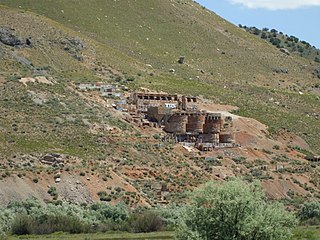
The Tintic Standard Reduction Mill—also known as the Tintic Mill or Harold Mill—built in 1920, and only operating from 1921 to 1925, is an abandoned refinery or concentrator located on the west slope of Warm Springs Mountain on the southern edge of Genola, Utah, United States. In 2002, the Utah Department of Environmental Quality tested the soil and found it contained high levels of arsenic and lead, which can lead to serious health problems and even death.

The Knight–Mangum House is a historic house located in Provo, Utah, United States. It is listed on the National Register of Historic Places. The mansion was built in the old English Tudor style, completed in 1908. It was built for Mr. W. Lester Mangum and his wife Jennie Knight Mangum. Mrs. Mangum was the daughter of the famous Utah mining man, Jesse Knight. The lot was purchased for $3,500 and the home was built at a cost of about $40,000. The Mangum family was able to afford the home due to the fact that they had sold their shares in Jesse Knight's mine located in Tintic, Utah, for eight dollars a share. They had purchased the shares for only twenty cents a share, so the excess allowed them enough funds to purchase the home. The contractors for the home were the Alexandis Brothers of Provo.
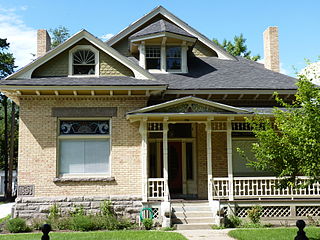
The Charles E. Loose House is a historic house located in Provo, Utah, United States. The house was individually nominated for listing on the National Register of Historic Places in 1982 but was not listed due to owner objection. It later was included as a contributing property in the Provo East Central Historic District.
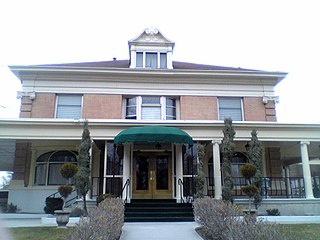
The Jesse Knight House, also known as the Knight Mansion, is a historic house in Provo, Utah, United States built for Jesse Knight. It was built in 1905, and added to the National Register of Historic Places in 1982. This home was designated to the Provo City Historic Landmarks Register on June 19, 1996.

The John R. Twelves House is a historic house located in Provo, Utah, United States. It is listed on the National Register of Historic Places.

The Knight–Allen House is a historic house located in Provo, Utah. It is listed on the National Register of Historic Places.

The Knight Block is a historic building located on South University Avenue in downtown Provo, Utah, United States. It is listed on the National Register of Historic Places.

The Provo Downtown Historic District is a 25-acre (10 ha) historic area located in Provo, Utah, United States. It is listed on the National Register of Historic Places.
The Beck No. 2 Mine near Eureka, Utah dates from 1890. It was listed on the National Register of Historic Places in 1979. The listing included "surface plant buildings" of the lead mine and one other contributing structure, a "remaining wooden headframe", described as a "fifty foot wooden headframe A-frame Montana type". These evoke the past mining operations at the site.
The Charcoal Kilns near Eureka, Utah were listed on the National Register of Historic Places in 1979. The listing included two charcoal kilns that each are about six feet in diameter and four feet deep, built out of stone. They are believed to have been built or used to support the Wyoming Smelter in 1871.
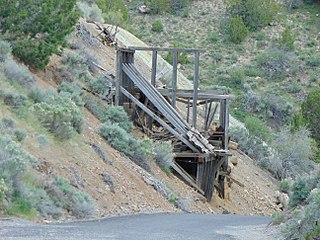
The Eureka Lilly Headframe is the surviving headframe at the Eureka Lilly mine in the Tintic Mining District in Dividend, Utah, United States, and is listed on the National Register of Historic Places.
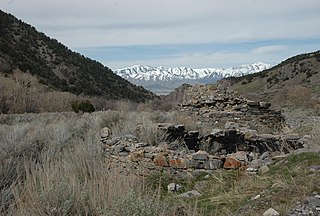
The Soldier Creek Kilns near Stockton, Utah date from about 1873, the time of their construction, and were in use up until about 1899. Also known as the Waterman Coking Ovens, they were listed on the National Register of Historic Places (NRHP) in 1980. The listing included 14 contributing structures over 30 acres (12 ha).
The Tybo Charcoal Kilns are a pair of charcoal kilns located 4 miles (6.4 km) north of Tybo, Nevada. Both kilns are 30 feet (9.1 m) tall and 25 feet (7.6 m) in diameter and were built from rocks and mud. The kilns each have three openings: a top opening, a door at ground level, and a rear window with a ramp for wood wagons. The kilns were among 15 built in 1874 for the Tybo Consolidated Company. The company, which mined the region's silver, used charcoal to fuel its smelting furnace. To acquire its fuel, it imported wood from nearby hills, which it then converted to charcoal in the kilns.
Diamond is a ghost town in eastern Juab County, Utah, United States. The Diamond Cemetery is listed on the National Register of Historic Places.
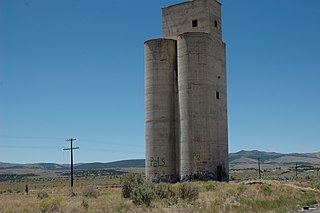
The Knight Grain Elevator, near Eureka, Utah, was built in 1915. It was listed on the National Register of Historic Places in 1979.
The Silver City Cemetery, is a historic cemetery in the ghost town of Silver City, Utah, United States, that dates from the 1870s and is listed on the National Register of Historic Places (NRHP).

The Tintic Smelter Site, located off U.S. Route 6 near Silver City, Utah, United States, that is listed on the National Register of Historic Places (NRHP).

The Eureka City Cemetery, located west of Eureka, Utah, United States, was established at its current location in 1894 and was listed on the National Register of Historic Places (NRHP) in 1979.
The Fitch Cemetery, located west of Eureka, Utah, United States, was established in 1920 and was listed on the National Register of Historic Places in 1979.














